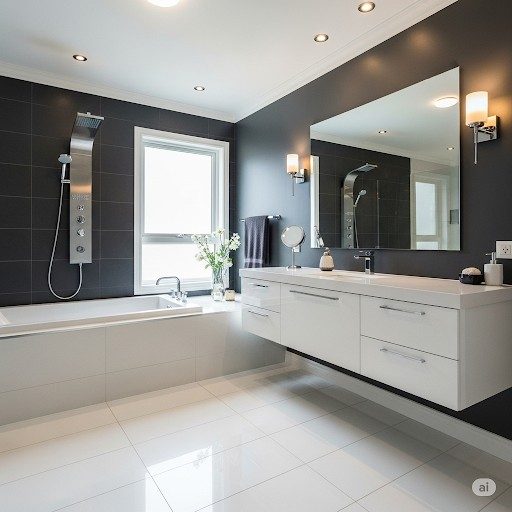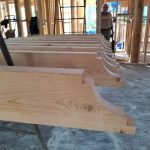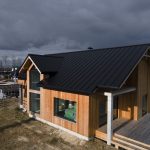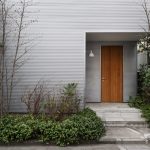
Bathroom Remodeling Design: Creating the Perfect Space
Transform Your Space with Expert Bathroom Remodeling Design
Bathroom remodeling design is the foundation of creating a functional, beautiful space that enhances your daily routine and adds significant value to your home. Whether you’re working with a compact powder room or a spacious master suite, thoughtful bathroom remodeling design choices can transform even the most outdated bathroom into a personal sanctuary. The key lies in understanding how to balance aesthetics with practicality while staying within your budget and timeline. Careful bathroom remodeling design ensures long-term satisfaction.
A well-executed bathroom remodeling design project requires careful consideration of multiple factors, from plumbing constraints to lighting requirements. Many homeowners feel overwhelmed by the countless decisions involved, but breaking the process into manageable steps makes it far less daunting. This comprehensive guide will walk you through every aspect of creating your dream bathroom. Avoiding costly mistakes during your bathroom remodeling design is crucial for maximizing your investment.
Essential Elements of Bathroom Remodeling Design
Planning Your Layout for Maximum Functionality
The foundation of any successful bathroom remodeling design starts with optimizing your floor plan. Before selecting tiles or fixtures, you need to understand how people will move through the space. Consider the “work triangle” concept—the relationship between your sink, toilet, and shower or bathtub. These three elements should be positioned to allow comfortable movement without feeling cramped. This efficient layout is key to successful bathroom remodeling design.
Traffic flow becomes especially important in shared bathrooms. If multiple family members use the space simultaneously, consider separating the toilet area or installing a double vanity. Small bathrooms benefit from strategic placement of the door swing and ensuring adequate clearance around each fixture. Clever space planning is essential in bathroom remodeling design.
Choosing the Right Materials and Finishes
Material selection plays a crucial role in both the functionality and aesthetics of your bathroom remodeling design. Bathrooms endure high humidity, temperature fluctuations, and frequent cleaning, so durability should be your top priority. Porcelain and ceramic tiles remain popular choices for floors and walls because they resist moisture and stains while offering endless design possibilities. Material choice significantly impacts the overall success of your bathroom remodeling design.
Natural stone materials like marble or granite create luxurious focal points but require more maintenance than engineered alternatives. Quartz countertops provide the beauty of stone with enhanced durability and stain resistance. When selecting finishes, consider how different materials will age and patina over time. For example, learn more about mixing materials in your bathroom remodel.
Incorporating Storage Solutions That Work
Effective storage design distinguishes exceptional bathroom remodeling design from merely attractive ones. Modern families accumulate numerous toiletries, towels, and cleaning supplies that need organized, accessible homes. Built-in niches within shower walls provide convenient storage without protruding into the space. Optimal storage is a hallmark of good bathroom remodeling design.
Vanity design offers the greatest storage potential in most bathrooms. Deep drawers with dividers work better than traditional cabinets with shelves for organizing small items. Consider adding vertical storage with tall linen cabinets or floating shelves. Smart storage solutions are crucial for a functional bathroom remodeling design.
Step-by-Step Bathroom Remodeling Design Process
Assessing Your Current Space and Needs
Begin your bathroom remodeling design journey by honestly evaluating your existing space and daily routines. Document what works well and identify frustrating aspects of your current bathroom. Take detailed measurements and photographs from multiple angles. Note the locations of existing plumbing, electrical outlets, and ventilation systems, as moving these significantly impacts your budget. Understanding your existing space is the first step in effective bathroom remodeling design.
Consider how your needs might change over time. Young families might prioritize bathtubs and easy-to-clean surfaces, while empty nesters often prefer walk-in showers and aging-in-place features. If you are still in the idea phase, take a look at other services.
Creating Your Design Vision and Budget
Successful bathroom remodeling design projects start with realistic budgets and clear design goals. Research current market prices for materials and labor in your area. Generally, bathroom remodels cost between $15,000 and $35,000, depending on size, quality of materials, and extent of changes. Allocate approximately 20% of your budget for unexpected issues that commonly arise during renovation. Budgeting is crucial for a successful bathroom remodeling design.
Selecting Fixtures and Features
Fixture selection significantly impacts both the functionality and budget of your bathroom remodeling design. Start with major elements like the bathtub, shower, toilet, and vanity before choosing smaller details. Quality fixtures often come with longer warranties and better performance, making them worthwhile investments. Don’t forget the importance of selecting the right cabinets and countertops to complete your design.
Planning for Plumbing and Electrical Changes
Understanding the implications of plumbing and electrical modifications helps you make informed decisions about your bathroom remodeling design. Moving major plumbing lines can add thousands to your project cost, especially in multi-story homes. However, relocating fixtures sometimes creates dramatically better layouts that justify the expense. Careful planning of these elements is vital for a successful bathroom remodeling design.
Popular Bathroom Remodeling Design Trends and Ideas
Modern Minimalist Approaches
Contemporary bathroom remodeling design often embraces clean lines and uncluttered spaces. Floating vanities create the illusion of more floor space while providing storage underneath. Large-format tiles reduce grout lines for sleeker appearances and easier maintenance.
Spa-Inspired Design Elements
Many homeowners incorporate spa-like features into their bathroom remodeling design to create relaxing retreats. Freestanding tubs serve as dramatic focal points while providing therapeutic benefits. Natural materials like wood and stone connect the space to nature and promote tranquility.
Lighting Design for Function and Ambiance
Thoughtful lighting design enhances both the functionality and atmosphere of your bathroom remodeling design. Layer different types of lighting to accommodate various activities and moods. Task lighting around mirrors eliminates shadows for grooming activities. Effective lighting is a key component of great bathroom remodeling design.
Maximizing Your Bathroom Remodeling Design Investment
Budget-Friendly Design Strategies
Smart bathroom remodeling design choices can deliver impressive results without breaking your budget. Refinishing existing vanities instead of replacing them saves money while updating appearances. Subway tiles offer timeless appeal at affordable prices.
High-Impact Changes That Add Value
Certain bathroom remodeling design improvements provide exceptional return on investment. Adding a second sink in master bathrooms appeals to couples and families. Converting bathtubs to walk-in showers suits aging populations and modern preferences. Another high-impact change that adds value is flooring sales and installation. These improvements add significant value to your bathroom remodeling design.
Common Bathroom Remodeling Design Mistakes to Avoid
Poor Space Planning and Layout Issues
Inadequate planning represents the most costly mistake in bathroom remodeling design projects. Failing to consider door swings, drawer clearances, and traffic patterns creates frustrating daily experiences. Always verify measurements multiple times and consider hiring professionals for complex layouts. Careful planning is essential to avoid these mistakes in bathroom remodeling design.
Inadequate Ventilation and Waterproofing
Proper ventilation prevents moisture damage that can destroy your beautiful bathroom remodeling design. Undersized exhaust fans fail to remove humidity effectively, leading to mold and mildew problems.
Choosing Style Over Function
While aesthetics matter in bathroom remodeling design, prioritizing appearance over functionality creates long-term dissatisfaction. Beautiful fixtures that perform poorly or materials that require excessive maintenance become daily frustrations.
The Foundation of Successful Home Transformation
Creating the perfect bathroom through thoughtful bathroom remodeling design requires balancing functionality, aesthetics, and budget considerations. A well-planned bathroom remodeling design serves as the cornerstone of any successful renovation, ensuring that your investment delivers both immediate satisfaction and long-term value.
The most successful projects begin with thorough planning and realistic expectations. Whether you’re pursuing a luxury spa retreat or a budget-friendly refresh, the principles of good design remain consistent: prioritize function over form, invest in quality infrastructure like waterproofing and ventilation, and make decisions that will serve your family’s needs for years to come. For larger projects, it may be best to do whole home remodeling.
Understanding common pitfalls helps homeowners avoid costly mistakes during their renovation journey. Poor space planning, inadequate ventilation, and choosing style over functionality are the most frequent errors that lead to dissatisfaction. Taking time to verify measurements, consider traffic patterns, and research fixture performance prevents regrets after construction begins.
Remember that professional guidance can make the difference between a good renovation and an exceptional one. Expert contractors and designers bring invaluable experience to complex bathroom remodeling design projects, helping you navigate challenges and maximize your investment while creating a space that truly enhances your daily life.
Ready to Transform Your Home?
At Mazzamuto Construction, we believe great spaces start with thoughtful planning and skilled craftsmanship. Whether you’re exploring ideas or ready to build, our team is here to guide you every step of the way. Let’s bring your vision home—reach out for a personalized consultation today! You can read testimonials from satisfied customers.
Frequently Asked Questions
1. What is a realistic budget for a bathroom remodel?
Most bathroom remodels range from $15,000 to $35,000 for mid-range renovations, while luxury projects can exceed $50,000.
2. In what order should a bathroom remodel be done?
Follow this sequence: demolition, plumbing and electrical rough-in, insulation and drywall, waterproofing, tile installation, fixture installation, painting, and final details.
3. Is $10,000 enough for a bathroom remodel?
A $10,000 budget works for basic updates in small bathrooms. However, moving plumbing or extensive tile work typically requires larger budgets.
4. Can I renovate my bathroom for $10,000?
Yes, with strategic choices. Keep existing layouts to avoid plumbing costs.
5. What’s the most expensive part of a bathroom renovation?
Labor typically represents 40-50% of total costs, followed by fixtures and materials.
Key Takeaways
- Prioritize function over form: Your bathroom remodeling design should enhance daily routines while looking beautiful.
- Plan thoroughly before starting: Careful planning prevents costly changes during construction.
- Invest in quality infrastructure: Spend money on proper waterproofing, ventilation, and plumbing.
- Professional help pays dividends: Complex bathroom remodeling design projects benefit from experienced contractors and designers.




